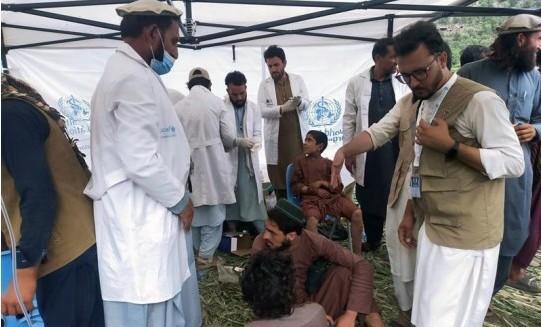WHO Appeals For Urgent Global Support To Tackle Afghans Quake Crisis
KABUL (Pajhwok): The World Health Organisation (WHO) has warned that a funding shortfall of over four million US dollars threatens to slow critical interventions for the victims of the devastating earthquake in eastern Afghanistan, where thousands of displaced families face severe health and humanitarian needs.
Three days have passed since the devastating 6.0 magnitude earthquake struck eastern Afghanistan, leaving widespread destruction across Kunar, Nangarhar, Laghman and Nuristan provinces.
In a report released on Wednesday night, the WHO said the scale of the disaster continues to unfold.
It said to date, more than 1400 people are confirmed dead, over 3300 injured, and at least 6700 homes destroyed. These figures are expected to rise further as search teams reach remote areas still cut off from assistance.
The report added:“Rescue operations remain extremely challenging, especially in the most affected areas, particularly Chawkay, Nurgal, Dara-e-Pech and Watapur in Kunar Province, which remain extremely hard to reach. Mountainous terrain, landslides and blocked roads continue to delay access, while recent rainfall has further complicated conditions.”
The WHO said that humanitarian partners have scaled up their efforts, deploying additional teams and resources to reach isolated and vulnerable communities.
Despite this, many survivors are still believed to be trapped beneath collapsed homes in remote villages, and the window for finding them alive is rapidly closing.
The organisation added:“The disaster has displaced thousands of families, many of whom are living in temporary shelters and exposed to continuing aftershocks. Local health facilities are under immense strain, facing shortages of trauma supplies,,essential medicines, and staff capacity.”
These shocks compound preexisting vulnerabilities in the region, including fragile health infrastructure, widespread poverty, food insecurity, and the recent influx of returnees from Pakistan.
An estimated 270 000 returnees have settled in the affected districts, further stretching already limited resources and leaving communities at heightened risk of secondary emergencies, such as disease outbreaks linked to overcrowding and poor sanitation.
Together with humanitarian partners, the WHO has expanded life-saving support, deployed mobile health and psychosocial support teams, and delivered medical supplies. Despite these efforts, urgent gaps remain.
A funding shortfall of over US$4 million threatens to slow critical interventions. Immediate, coordinated international support is to safeguard lives and prevent the crisis from deepening further
kk/ma

Legal Disclaimer:
MENAFN provides the
information “as is” without warranty of any kind. We do not accept
any responsibility or liability for the accuracy, content, images,
videos, licenses, completeness, legality, or reliability of the information
contained in this article. If you have any complaints or copyright
issues related to this article, kindly contact the provider above.
Most popular stories
Market Research

- Wallpaper Market Size, Industry Overview, Latest Insights And Forecast 2025-2033
- GCL Subsidiary, 2Game Digital, Partners With Kucoin Pay To Accept Secure Crypto Payments In Real Time
- North America Perms And Relaxants Market Size, Share And Growth Report 2025-2033
- Chaingpt Pad Unveils Buzz System: Turning Social Hype Into Token Allocation
- Invromining Expands Multi-Asset Mining Platform, Launches New AI-Driven Infrastructure
- Global Mobile Wallet Market Size Projected To Reach USD 701.0 Billion By 2033 CAGR Of 15.09%.



















Comments
No comment